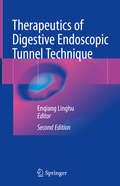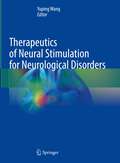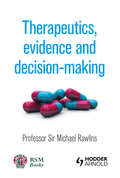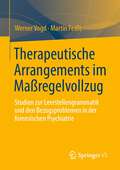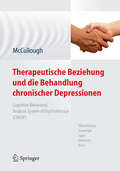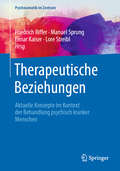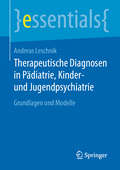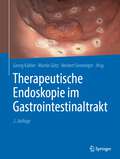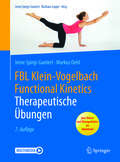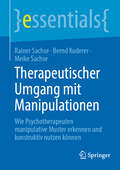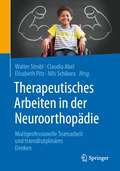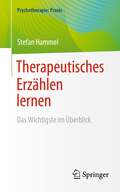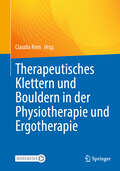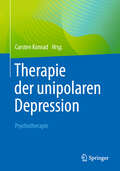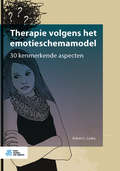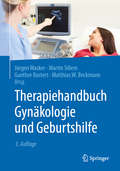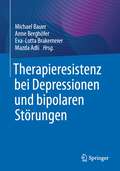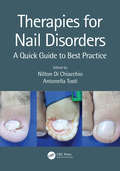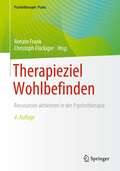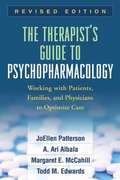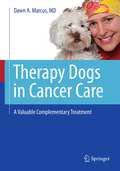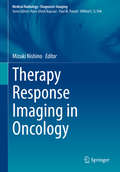- Table View
- List View
Therapeutics of Digestive Endoscopic Tunnel Technique
by Enqiang LinghuThis book elaborates on a whole new understanding of digestive endoscopy, the core of which is to treat quite a number of diseases using minimally invasive methods. Currently, the tunnel technique has been applied in the treatment of digestive early stage carcinomas, esophageal achalasia and submucosal tumors originating from muscularis propria. And this promising technique would surely be more widely used in the future. The main contents of this book include the history of the digestive endoscopic tunnel technique, the practical anatomy involved, operation steps, indications and contraindications, complications and possible future exploration fields. This book is well suited for doctors and surgeons performing digestive endoscopic therapies.
Therapeutics of Neural Stimulation for Neurological Disorders
by Yuping WangThis book mainly focuses on diversity of brain diseases, such as sleep disorders, major depression disorder, anxiety disorders, epilepsy, cognitive disorders, etc. It introduces the current pathological mechanisms of various diseases from the perspective of basic theories and research; it introduces the clinical evaluation and treatment of the above diseases from the clinical perspective. In addition, the current frontier research on therapeutics of neural stimulation for the above brain disorder was introduced, such as Transcranial electrical stimulation, magnetic stimulation, ultrasonic stimulation, etc., and the therapeutic strategy and stimuli parameters for reference were proposed.This book is aimed at clinical students, doctors and researchers in the field of neurology. Based on major brain diseases, this book systematically proposed the maneuverability, safety and effectiveness of neural stimulation technologies in the treatment of major brain diseases.
Therapeutics, Evidence and Decision-Making
by Michael RawlinsThis book is intended to help decision-makers use, assess and appraise the evidence that underpins decisions about the use of therapeutic interventions. It will inform decision-makers about the nature of evidence, the strengths and weaknesses of the available approaches, and how these can be most effectively distilled for the purpose of reaching re
Therapeutische Arrangements im Maßregelvollzug: Studien zur Leerstellengrammatik und den Bezugsproblemen in der forensischen Psychiatrie
by Werner Vogd Martin FeißtAuf Basis von Feldforschungen und Interviews in 6 forensischen Kliniken werden die Herausforderungen der Therapie und Resozialisierung im Maßregelvollzug untersucht. Es werden grundlegende Dilemmata der Therapie unter Zwang herausgearbeitet und typische Probleme und Chancen aufgezeigt, die mit Versuch der Normalisierung der Patienten einhergehen. Es wird eine systemische Analyseperspektive gewählt, die den Blick sowohl auf die konkreten Beziehungen wie auch das organisationale Gefüge und seiner gesellschaftlichen Einbettung lenkt.
Therapeutische Beziehung und die Behandlung chronischer Depressionen
by Valerija Sipos Philipp Klein Antje Demmert James P. Mccullough Jr. Ulrich SchweigerCBASP (Cognitive Behavioral Analysis System of Psychotherapy) hebt das Neutralitätsprinzip des Therapeuten auf Seit mehr als einem Jahrhundert wird die Rolle des Psychotherapeuten dominiert durch Freuds Neutralitätsregel: Ein Therapeut darf die Beziehung zu seinen Patienten nicht persönlich gestalten. James P. McCullough, Jr., hinterfragt dieses weit verbreitete Diktum mit seinem neuen Behandlungsansatz für chronische depressive Patienten: Er empfiehlt eine diszipliniert persönliche Gestaltung der therapeutischen Beziehung statt therapeutischer Neutralität. Die therapeutische Beziehung kann auf diese Weise konkret eingesetzt werden, um pathologische Verhaltensmuster chronisch depressiver Patienten zu verändern. Die neue methodische Gestaltung der persönlichen Therapiebeziehung mit chronisch depressiven Patienten In diesem Buch beschreibt James P. McCullough, Jr., detailliert und anhand zahlreicher einprägsamer Fallbeispiele, wie er eine diszipliniert persönliche Gestaltung der therapeutischen Beziehung definiert und wie sie angewendet wird. Seine psychotherapeutische Erfahrung gepaart mit seinem frischen Blick auf die therapeutische Beziehung machen das Buch zu einer spannenden Lektüre für alle praktizierenden Psychotherapeuten und Psychotherapieforscher. Übersetzt und bearbeitet von den Fachleuten der Methode im deutschsprachigen Raum
Therapeutische Beziehungen: Aktuelle Konzepte im Kontext der Behandlung psychisch kranker Menschen (Psychosomatik im Zentrum #4)
by Friedrich Riffer Elmar Kaiser Manuel Sprung Lore StreiblGute zwischenmenschliche Beziehungen sind von grundlegender Bedeutung für jede Form der therapeutischen Arbeit. Das vierte Buch in der Reihe Psychosomatik im Zentrum widmet sich den Ansprüchen und Realitäten, Chancen und Risiken der therapeutischen Arbeit mit psychisch kranken Menschen. Fritz Riffer eröffnet mit der wichtigen Frage, was die gute Therapeutin und ihre therapeutischen Beziehungen ausmacht. Weitere Beiträge beschäftigen sich mit realistischen Ansprüchen und Erwartungen an Therapeuten, Übertragungsphänomenen sowie Liebe und erotischem Erleben in therapeutischen Beziehungen. Anschließend werden Chancen von achtsamkeitsbasierten und systemischen Herangehensweisen sowie Filmtherapie und tiergestützter Entwicklungsförderung aufgezeigt. Mögliche Risiken, wie etwa Grenzüberschreitungen, Aggression und Gewalt sowie sekundäre Traumatisierung werden ebenso thematisiert.Dieses Buch richtet sich in erster Linie an Ärzte, Psychotherapeuten, Klinische- und Gesundheitspsychologen sowie verwandte Berufsgruppen, die therapeutische Beziehungen mit psychisch kranken Menschen gestalten.
Therapeutische Diagnosen in Pädiatrie, Kinder- und Jugendpsychiatrie: Grundlagen und Modelle (essentials)
by Andreas LeschnikIn Deutschland haben wir zwei Klassifikationsmodelle, um Kinder mit Problemen und Ressourcen ganzheitlich zu erfassen. Zum einen die ICD-10 (International Statistical Classification of Diseases and Related Health Problems 10. Revision) und zum anderen die ICF-CY (International Classification of Functioning, Disability and Health. Children and Youth Version). In der Vergangenheit hat sich aber gezeigt, dass die ICD-10 und die ICF-CY nicht in Kombination miteinander benutzt werden. Somit entsteht automatisch eine nicht vollständige Diagnostik. Beide Klassifikationsmodelle wurden aber so entwickelt, dass sie aufeinander abgestimmt sind und sich somit ergänzen. Allerdings haben diese Model keine Leitlinie, wann und wo man sie in einem Prozess zum Erstellen einer therapeutischen Diagnose einsetzt. Dieses Buch soll aufzeigen, welche Modelle man benötigt, um eine therapeutische Diagnose zu erstellen.
Therapeutische Endoskopie im Gastrointestinaltrakt
by Georg Kähler Martin Götz Norbert SenningerAuch in der 2. Auflage des Buches ist die Vielfalt der etablierten und modernen endoskopisch-therapeutischen Interventionen von Experten aus Viszeralchirurgie und Gastroenterologie systematisch, umfassend und praxisnah dargestellt. Zahlreiche endoskopische Bilder und Schemazeichnungen illustrieren die Beschreibungen der Therapieverfahren.Zu jedem endoskopischen Verfahren sind beschrieben:- Indikationen- personelle, instrumentelle und technische Voraussetzungen- Durchführung- Ergebnisse- Limitationen, Komplikationen und deren Management.Alle Beiträge wurden aktualisiert; neu hinzugekommen ist ein eigenes Kapitel über Hygienemaßnahmen. Praktische Tipps und Hinweise auf alternative Vorgehensweisen sprechen den jungen Facharzt ebenso an wie den erfahrenen Endoskopiker und Endoskopie-Fachkräfte aus anderen Berufsgruppen.
Therapeutische Übungen (FBL Klein-Vogelbach Functional Kinetics)
by Irene Spirgi-Gantert Markus OehlAnleitung zu einem umfassenden Übungsprogramm, das auf den therapeutischen Beobachtungs- und Behandlungsprinzipien des Grundlagenbuchs "FBL: Bewegung lehren und lernen" aufbaut. Erprobte Übungen für den Patientenbeschwerden angepasstes Training aller Körperregionen bei funktionellen Störungen oder Beeinträchtigungen des Bewegungssystems. Konkrete Hinweise zu Patientenschulung, Analyse und individueller Korrektur von Haltung und Bewegung. Neu in der 5. Auflage: großzügiges Format, Layout. Übungsnamen und -anleitungen in gebräuchlicher Physiotherapie-Fachsprache übertragen. Jetzt mit DVD: Viele Übungen in "bewegten Bildern" als Videosequenzen!
Therapeutischer Umgang mit Manipulationen: Wie Psychotherapeuten manipulative Muster erkennen und konstruktiv nutzen können (essentials)
by Rainer Sachse Bernd Kuderer Meike SachseIn diesem essential erfahren Psychotherapeuten, Psychosomatische Mediziner, Psychiater, Berater, wie Klientinnen und Klienten mit sogenannten Persönlichkeitsakzentuierungen oder Persönlichkeitsstörungen versuchen, die Therapeutinnen und Therapeuten im Therapie-Prozess zu manipulieren. Dies erzeugt für Therapeuten schwierige Interaktionssituationen. Das Buch beschreibt, wie Therapeuten solche Manipulationen erkennen und wie sie damit konstruktiv umgehen können.
Therapeutisches Arbeiten in der Neuroorthopädie: Multiprofessionelle Teamarbeit und transdisziplinäres Denken
by Walter Michael Strobl Nils Schikora Elisabeth Pitz Claudia AbelDieses Lehr- und Praxisbuch liefert Therapeuten, Pädagogen und Angehörigen von Pflegeberufen die perfekte Grundlage für die umfassende Betreuung von Patienten mit komplexen neuromotorischen Erkrankungen. Renommierte Autoren verschiedenster Fachdisziplinen haben aus Forschung und Praxis ihren Erfahrungsschatz systematisch zusammengetragen und didaktisch aufbereitet. Die innovative, in praktische Funktionsbereiche aufgeteilte Untergliederung ermöglicht einen schnellen Zugriff auf dieses Wissen und erleichtert die Umsetzung in den praktischen Alltag.Die Theorie• Erklärung der neurophysiologischen Wechselwirkungen des Bewegungssystems, Grundlagen der Entwicklung, Sensomotorik, Bewegungsanalyse, des Motorischen Lernens und der Rehabilitation • Untersuchungstechniken, Befundsysteme, Assessments und Analyse der Bewegungsorgane• Krankheits- und altersbezogene Entwicklung von Bewegungseinschränkungen und Deformitäten und neuroorthopädische Konzepte für deren frühzeitige Prävention und Therapie • Basiswissen zu körperlicher und geistiger Behinderung und deren Ausgleichsmöglichkeiten• Darstellung der wichtigsten sozialrechtlichen Ansprüche und psychosozialen ZusammenhängeDie Praxis• Nach den wichtigsten motorischen Grundfähigkeiten Nahrungsaufnahme, Sprache, Greifen und Stützen, Sitzen, Stehen, Gehen und alltagsrelevanten Transfers gegliedert• Behandlungsgrundsätze und konkrete Behandlungsvorschläge für spastische und schlaffe Tonusverhältnisse sowie für Muskelerkrankungen• Hands-off- und Hands-on-Methoden für alle Beschwerdebilder• Praktische Anleitung der Hilfsmittelversorgung mit Reha- und Orthopädietechnik
Therapeutisches Erzählen lernen: Das Wichtigste im Überblick (Psychotherapie: Praxis)
by Stefan HammelDas Buch gibt eine hypnosystemisch fundierte Einführung in das therapeutische Erzählen in Medizin, Kindertherapie und Erwachsenenpsychotherapie, Paartherapie, Familientherapie, Sozialarbeit, Seelsorge, Pädagogik, Coaching, Supervision und verwandten Berufsfeldern. Aus dem Inhalt: Was Geschichtenerzählen mit Therapie zu tun hat. Warum, wann und wie Geschichten therapeutisch wirken. Wo ich therapeutische Geschichten einsetzen kann. Wie ich die rechte Geschichte zur rechten Zeit finde. Wie ich eine therapeutische Geschichte strukturiere. Wie ich anfange und wie ich weitermache. Wie ich meine erzählerischen Fähigkeiten erweitere. Über den Autor: Stefan Hammel arbeitet als systemischer Therapeut, Hypnotherapeut und Autor, als evangelischer Klinik- und Psychiatrieseelsorger sowie als Leiter des Instituts für Hypnosystemische Beratung in Kaiserslautern und als Referent systemischer und hypnotherapeutischer Ausbildungsinstitute in Deutschland, Österreich und in der Schweiz. Er hält Seminare zu Erickson'scher Hypnotherapie, therapeutischem Erzählen, systemischer und hypnosystemischer Beratung. Arbeitsschwerpunkte liegen in den Bereichen Paar- und Familientherapie, Kinder- und Jugendlichentherapie, Depression, Angst, Trauma, Sterbe- und Trauerbegleitung sowie der Unterstützung somatischer Heilung.
Therapeutisches Klettern und Bouldern in der Physiotherapie und Ergotherapie
by Claudia KernDieses Praxisbuch liefert Ihnen die notwendigen Grundlagen für die Einführung und Umsetzung des Therapeutischen Kletterns und Boulderns im therapeutischen Alltag. Erfahren Sie, wie gezielte kletterbasierte Interventionen dazu beitragen können, spezielle Patientengruppen optimal zu unterstützen. Sie erhalten umfassende Informationen für eine ganzheitliche Durchführung der Klettertherapie, einschließlich spezifischer Anforderungen und Potenziale des Kletterns in der eigenen Praxis. Ideal für die Physiotherapie, Ergotherapie, Sportwissenschaft und Bewegungstherapie sowie weitere an der Therapie beteiligten Berufsgruppen. Aus dem Inhalt: Grundlegende Bewegungsabläufe des Kletterns, Gestaltung der Boulderwände und Routen, Sicherungsmöglichkeiten und Rahmenbedingungen, spezielle Anwendung in der Orthopädie, Neurologie, Psychiatrie und Pädiatrie, Behandlungsaufbau mit Bewegungssequenzen und Spielen, Patientenbeispiele für Anfänger*innen und Fortgeschrittene, Plus: Fotos und Videos zu Bewegungsabläufen und Onlinematerialien für die Therapie.
Therapie der unipolaren Depression - Psychotherapie
by Carsten KonradDieses Buch stellt die gängigen psychotherapeutischen Verfahren dar, die in der Behandlung der unipolaren Depression eingesetzt werden können.Jedes Kapitel widmet sich der Darstellung eines für die Depressionsbehandlung geeigneten Psychotherapieverfahrens. Jedes Kapitel wird von der Schilderung eines typischen Falls durchzogen, an dem die einzelnen Interventionen im Therapieverlauf illustriert werden. Die Psychotherapieverfahren werden in einzelne Handlungsschritte (Module) unterteilt und mit Online-Materialien wie Arbeitsblätter, Informationsmaterialien, Aufklärungsbögen etc. unterlegt. Ziel des Buches ist es, eine praxisnahe Anleitung zu den verschiedenen Psychotherapieverfahren zu geben. Das Lesen einzelner Kapitel ohne den Zusammenhang mit den anderen Kapiteln ist möglich.Das Buch stellt die Fortführung und Aktualisierung der Psychotherapie-Sektion in Konrad, C.: Therapie der Depression – Praxisbuch der Behandlungsmethoden, Springer 2017, dar und richtetsich in erster Linie an psychotherapeutisch tätige Ärzt:innen und Psycholog:innen, die sich für eine moderne psychotherapeutische Behandlung der Depression interessieren.
Therapie volgens het emotieschemamodel: 30 kenmerkende aspecten
by Robert L. LeahyDit boek helpt zorgprofessionals bij de behandeling van cliënten met complexe emoties. Met het beschreven emotieschemamodel krijgen cliënten inzicht in hun emotieschema’s en leren ze ermee om te gaan. Het boek is bedoeld voor psychotherapeuten, psychiaters, psychologen en andere hulpverleners die zich willen verdiepen in emoties en emotieregulatie. Therapie volgens het emotieschemamodel: 30 kenmerkende aspecten beschrijft een nieuw model en biedt nieuwe inzichten over de manier waarop we denken over emoties, hoe we emoties waarderen en hoe we ermee omgaan. Hiervoor combineert de auteur zijn praktijkervaring met theorieën over cognitie, metacognitie en compassie. U leest hoe cliënten manieren kunnen ontwikkelen om met hun emoties om te gaan en deze te accepteren. Daarbij wordt onder andere ingegaan op emotieregulatiestrategieën, persoonlijk empowerment en interpersoonlijke emotieschema’s. De theorie in het boek wordt verduidelijkt met voorbeelden uit de praktijk. De instrumenten die aangereikt worden, zijn direct te gebruiken binnen bestaande behandelingen. Het boek is bondig geschreven en in compacte vorm uitgegeven. Hierdoor is het ideaal om als naslagwerk te gebruiken. Dr. Robert L. Leahy is onderzoeker en heeft jarenlange klinische ervaring. Hij is directeur van het American Institute for Cognitive Therapy in New York en is als Clinical Professor of Psychology, verbonden aan het Department of Psychiatry van Weill Cornell Medical College.
Therapie von Schmerzstörungen im Kindes- und Jugendalter
by Michael Dobe Boris ZernikowCa. 300.000 Kinder- und Jugendliche sind in Deutschland von chronischen Schmerzen betroffen, fehlen damit in der Schule und sind in ihrem sozialen Leben stark benachteiligt. Gezielt helfen kann nur der jenige, der sich mit dem Krankheitsbild, der notwendigen Diagnostik und Therapie ausreichend auskennt. Das Buch stellt das erprobte stationäre Schmerztherapieprogramm des Deutschen Kinderschmerzzentrums (DKSZ) an der Vestischen Kinder- und Jugenklinik in Datteln - Universität Witten/Herdecke vor. Es zeigt die professionelle Behandlung und den Umgang mit schmerzkranken Kindern und Jugendlichen auf: · Fachwissen, um die Ursache von chronischem Schmerz zu verstehen · Erfolgreiche Behandlungsmöglichkeiten basierend auf langjähriger, klinischer Erfahrung · Tages- und Therapiestruktur, Interventionen des Pflege- und Erziehungsteams (PET) und anderer beteiligter Berufsgruppen · Plus: Arbeitsmaterialien zur Erhebung von Ressourcen und besonderen Belastungsfaktoren Ambulante und stationäre Einrichtungen können mit dem Konzept eine wirksame stationäre Schmerztherapie für Kinder mit einer Schmerzstörung anbieten. Für ambulant tätige Psychotherapeuten, Pädiater und Schmerztherapeuten, die gezielt und konkret einen Überblick über Therapiemöglichkeiten und Inteventionen schmerzkranker Kinder und deren Familien suchen.
Therapiehandbuch Gynäkologie und Geburtshilfe
by Martin Sillem Jürgen Wacker Gunther Bastert Matthias W. BeckmannDas erfahrene Herausgeber- und Autorenteam stellt in dem Handbuch alle üblichen Diagnose- und Therapieschritte praxisorientiert und alltagstauglich dar: von den Grundlagen der Evidenz und den Leitlinien über die Versorgung und Früherkennung in Geburtshilfe und gynäkologischer Onkologie bis hin zu Therapiestrategien und Notfallmanagement. Dabei ist der neueste Stand der Forschung berücksichtigt. Die 2. Auflage wurde umfassend bearbeitet, aktualisiert und um Kapitel u. a. zum Vulvakarzinom und zur komplementärenTherapie in der Onkologie erweitert.
Therapieresistenz bei Depressionen und bipolaren Störungen
by Michael Bauer Anne Berghöfer Mazda Adli Eva-Lotta BrakemeierTherapieresistente depressive und bipolare Störungen stellen ungebrochen eine klinische Herausforderung dar: Therapeutisches Nichtansprechen bzw. Therapieresistenz depressiver und bipolarer Erkrankungen sind nicht nur häufig, sie erfordern oft auch eine stationäre Behandlung. Für Betroffene und Angehörige bedeutet das erhebliche Einschränkungen der Lebensqualität und der sozialen und beruflichen Funktionsfähigkeit. Therapieresistente Verläufe verursachen gleichzeitig sehr hohe Behandlungskosten.Um dieser Herausforderung zu begegnen, steht heute ein breites Spektrum pharmakologischer, psychotherapeutischer und psychosozialer Behandlungsmöglichkeiten zur Verfügung, das spezielle Kenntnisse und Erfahrungen voraussetzt. In diesem Buch stellen daher namhafte ExpertInnen in kurzen, prägnanten Kapiteln wissenschaftlich fundiert und mit hohem Praxisbezug den aktuellen Wissensstand dar und bieten Leitlinien für die Behandlung in Klinik und Praxis.Dabei werden auch neue Methoden, wie weiterentwickelte Hirnstimulationsverfahren, Chancen und Grenzen pharmakogenetischer Methoden zur präziseren Therapieempfehlung („bedside genotyping“), neue psychotherapeutische und pharmakologische Ansätze sowie innovative integrierte Versorgungsformen berücksichtigt. Das Buch richtet sich an PsychiaterInnen, NervenärztInnen, PsychotherapeutInnen und PsychologInnen, insbesondere im stationären Setting, aber auch in spezialisierten Praxen, sowie WissenschaftlerInnen von Forschungseinrichtungen und Industrieunternehmen.
Therapies for Nail Disorders: A Quick Guide to Best Practice
by Antonella Tosti Nilton Di ChiacchioThis concise text presents the essential points of diagnosis and a quick guide to what are currently the best evidence-based practices in treatment methods. In addition to material on the diseases themselves, there are useful appendices on how to carry out ancillary procedures. Contents: Acute paronychia * Bowen disease * Brittle nails * Chronic paronychia * Eczema * Erythronychia * Glomus tumor * Hematomas * Herpes simplex * Ingrowing nail * Lichen planus * Melanoma * Melanonychias * Myxoid cysts * Onycholysis * Onychomatricoma * Onychomycosis * Onychotillomania * Psoriasis * Retronychia * Squamous cell carcinoma * Subungual exostosis * Trachyonychia * Transverse overcurvature * Warts * Yellow nail syndrome * Practical procedures * Preparing a biopsy specimen
Therapieziel Wohlbefinden: Ressourcen aktivieren in der Psychotherapie (Psychotherapie: Praxis)
by Renate Frank Christoph FlückigerDieses Buch stellt Psychotherapieansätze vor, die sich spezifisch auf Wohlbefinden, menschliche Stärken und seelische Gesundheit konzentrieren, u. a. ressourcenorientierte Psychotherapie, euthyme Therapie, Well-Being-Therapie, Mindfulness Based Therapy sowie narrative und Sinn fördernde Ansätze. Positive Psychologie und Wohlbefindensforschung finden immer mehr Beachtung: Was sind die Auswirkungen von Wohlbefinden, positiven Gefühlen, Zufriedenheit, konstruktiven Gedanken und eigenen Stärken? Wie begünstigen diese auch angesichts von Stress und Lebensbeeinträchtigungen ein erfülltes, produktives Leben? Und: Wie lässt sich Wohlbefinden im Rahmen einer Psychotherapie ganz direkt fördern? Geschrieben für ... Psychologische und Ärztliche Psychotherapeuten, Kinder- und Jugendlichenpsychotherapeuten, Psychiater, Klinische Psychologen. Über die Herausgeber:innen: Dr. Renate Frank, promovierte Psychologin und Psychotherapeutin. Sie leitete die verhaltenstherapeutische Ambulanz der Universität Gießen; ihre Arbeits- und Forschungsschwerpunkte: Wohlbefinden und Lebensqualität. Prof. Dr. phil. Christoph Flückiger, Psychotherapeut und Supervisor, Leiter der Spezialpraxis für Generalisierte Angststörungen Universität Zürich; seine Forschungs- und Lehrinteressen: Erforschung allgemeiner Wirkfaktoren in der Psychotherapie und in psychologischen Interventionen.
Therapist's Guide to Psychopharmacology, Revised Edition
by Joellen Patterson A. Ari AlbalaThis indispensable book provides therapists and counselors with crucial knowledge about psychotropic medications when and how to make medication referrals, how to answer patients' questions and help them handle problems that arise, and how to combine medication and psychotherapy effectively. Ideal for readers without extensive background in neurobiology, the book clearly explains how medications work in the brain and how they affect an individual's emotions, behavior, and relationships. Strategies for collaborating successfully with patients, their family members, and prescribers are discussed in detail. In this edition, psychopharmacology content has been fully updated.
Therapy Dogs in Cancer Care
by Dawn A. MarcusDogs that visit patients with cancer have been convincingly shown to reduce stress, loneliness, and mood disturbance that may complicate cancer care. In addition, dogs may provide important motivation for patients to maintain rehabilitation programs that have been shown to reduce cancer risk and improve cancer survival. Outlining all of these issues and many more, Therapy Dogs in Cancer Care: A Valuable Complementary Treatment is a ground-breaking, highly innovative addition to the literature on cancer care. Detailing a comprehensive summary of truly impressive research demonstrating the ability of dogs to serve an important therapeutic role within the cancer arena and in other serious medical conditions, the text provides highly practical advice and very helpful "tips" to ensure that those who wish to employ dogs to assist the cancer patient have the necessary knowledge and "tools" to optimize outcomes. Authored by Dawn A. Marcus, MD, an expert in both pain management and health improvement through human and dog interaction, Therapy Dogs in Cancer Care: A Valuable Complementary Treatment is an extremely well-organized, well-researched, and highly readable book. Providing practical suggestions to effectively incorporate dogs into cancer care, with detailed instructions about requirements for therapy dogs to ensure visits are safe and limit unwanted spread of infection, Therapy Dogs in Cancer Care: A Valuable Complementary Treatment is an invaluable reference that will inform and delight both the clinician desiring a "how-to" text as well as the casual reader.
Therapy Pup to Heal the Surgeon
by Alison RobertsWhen a therapy pup takes a liking to the pediatric surgeon, will her human companion follow her lead? Find out in Alison Roberts&’s latest Harlequin Medical Romance! HIS EMOTIONS ARE ON A TIGHT LEASH… When pediatric surgeon Hugh meets nurse Molly and her therapy pup, &“Dogtor&” Oreo, neither makes a good impression! Focused Hugh does not appreciate distractions in his clinic, while Molly&’s protective of the benefits to their patients. Yet outside work, she discovers he&’s not quite so buttoned-up—and Oreo agrees! Their connection is undeniable, and her lovable collie seems determined to bring them together. But can Molly and her dog heal Hugh&’s fiercely guarded heart?From Harlequin Medical: Life and love in the world of modern medicine.
Therapy Response Imaging in Oncology (Medical Radiology)
by Mizuki NishinoThis book is a detailed guide to therapy response imaging in cancer patients that fully takes into account the revolutionary progress and paradigm shift in treatment approaches for advanced disease. The opening chapters describe the role of imaging as a “common language” for tumor response evaluation in oncology and address challenges and strategies in the era of precision cancer therapy and cancer immunotherapy. Practical pitfalls are discussed, with emphasis on the importance of approaching cancer as a systemic disease and the need for increased awareness of drug toxicity due to novel therapies. Therapy response imaging in a wide range of cancer types is then comprehensively described and illustrated, using a disease-specific approach. A concluding section focuses on emerging approaches and future directions, including radiomics/radiogenomics, co-clinical imaging, and molecular and functional imaging. Therapy Response Imaging in Oncology will be of high value for radiologists, nuclear medicine physicians, and oncologists. It will also be of interest to cancer care providers and oncology trial investigators.
Therapy Tech: The Digital Transformation of Mental Healthcare
by Emma Bedor HilandA pointed look at the state of tech-based mental healthcare and what we must do to change it Proponents of technology trumpet it as the solution to the massive increase in the mental distress that confronts our nation. They herald the arrival of algorithms, intelligent chatbots, smartphone applications, telemental healthcare services, and more—but are these technological fixes really as good as they seem? In Therapy Tech, Emma Bedor Hiland presents the first comprehensive study of how technology has transformed mental healthcare, showing that this revolution can&’t deliver what it promises.Far from providing a solution, technological mental healthcare perpetuates preexisting disparities while relying on the same failed focus on personal responsibility that has let us down before. Through vivid, in-depth case studies, Therapy Tech reveals these problems, covering issues including psychosurveillance on websites like Facebook and 7 Cups of Tea, shortcomings of popular AI &“doctors on demand&” like Woebot, Wysa, and Joy, and even how therapists are being conscripted into the gig economy.Featuring a vital coda that brings Therapy Tech up to date for the COVID era, this book is the first to give readers a large-scale analysis of mental health technologies and the cultural changes they have enabled. Both a sobering dissection of the current state of mental health and a necessary warning of where things are headed, Therapy Tech makes an important assertion about how to help those in need of mental health services today.
